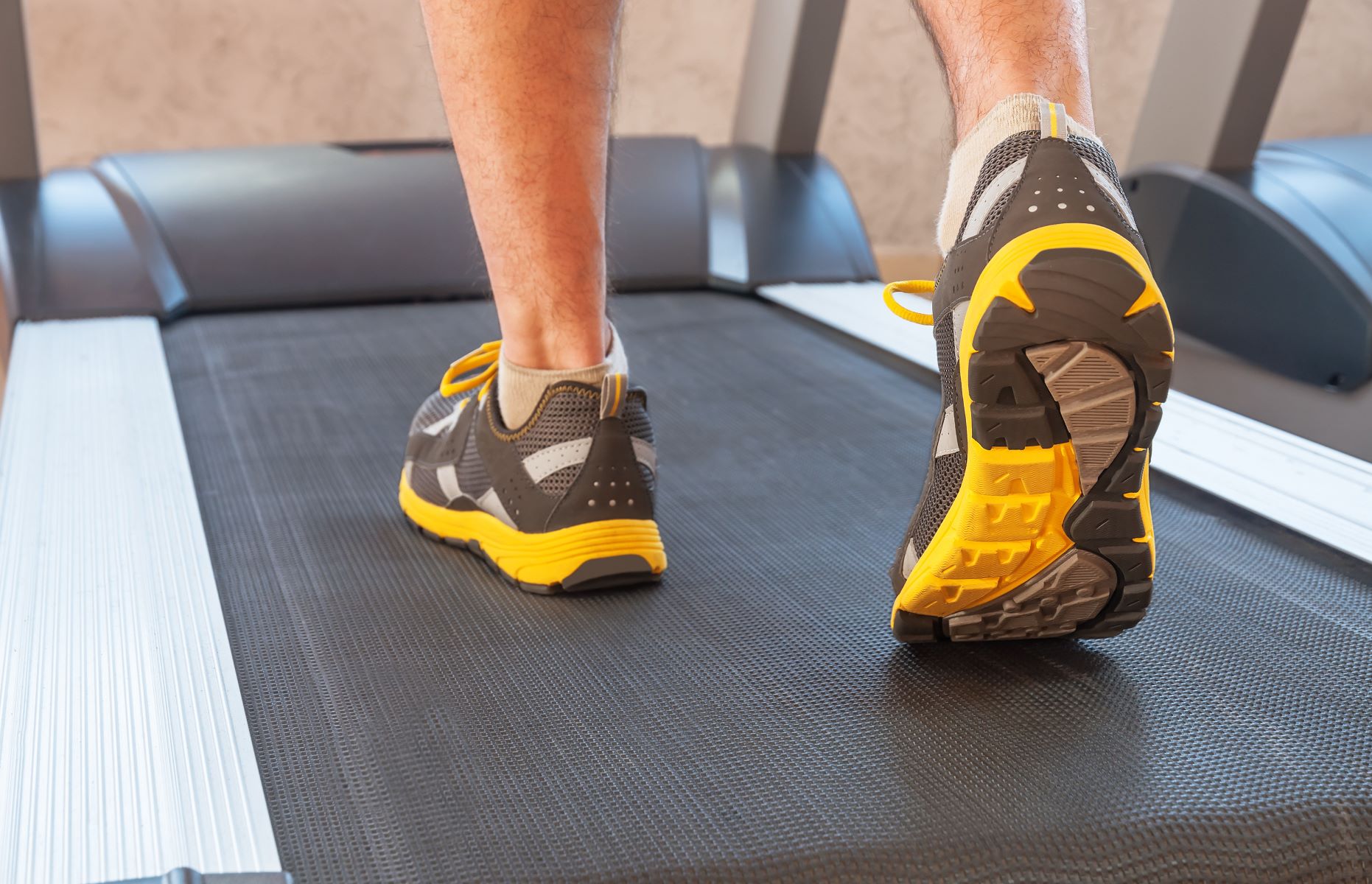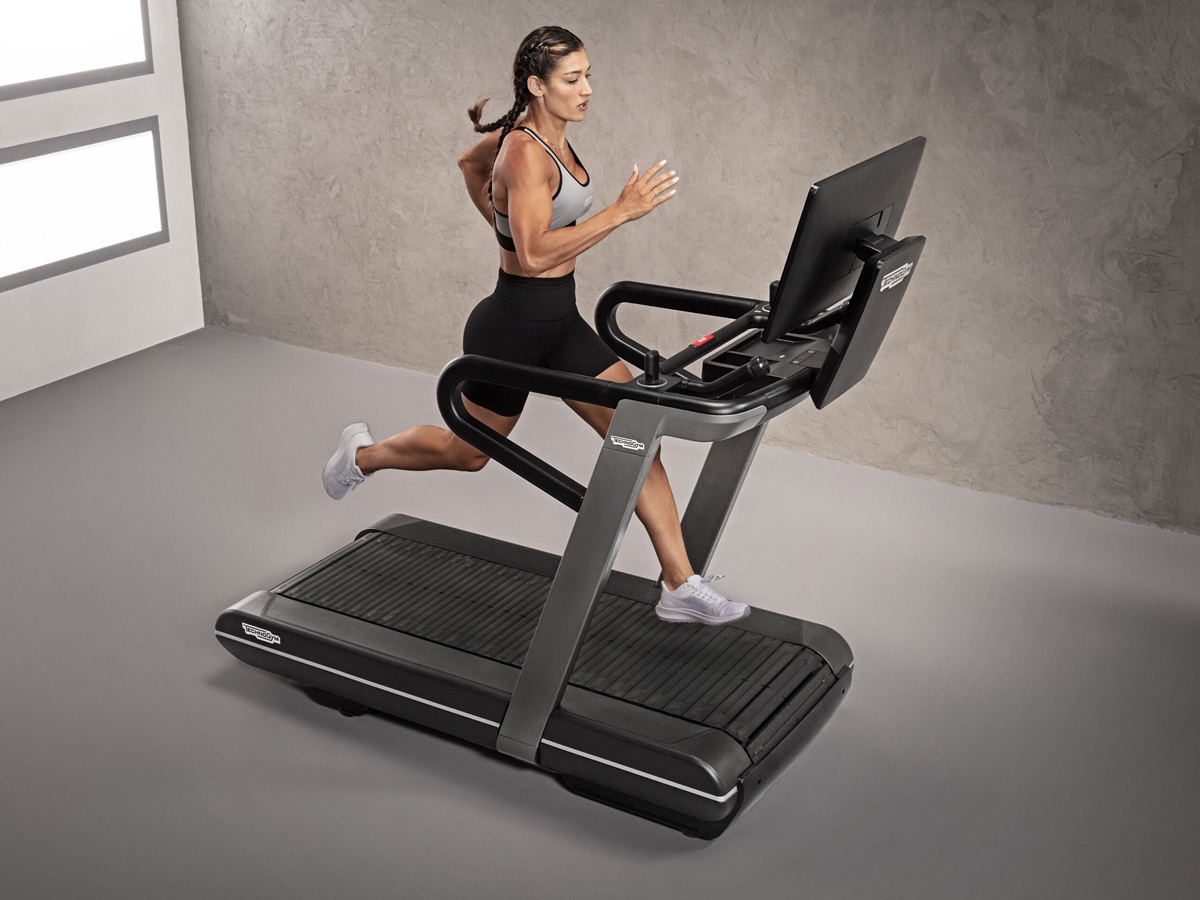

Featured
Why My Lower Back Hurts When Jogging
Modified: March 1, 2024
Discover why your lower back hurts when jogging and get expert tips to prevent and alleviate the pain. Featured solutions for a pain-free workout!
Introduction
Welcome to your comprehensive guide on why your lower back hurts when jogging. Jogging is a popular activity that provides numerous health benefits. It helps to strengthen muscles, improve cardiovascular health, and boost overall fitness. However, many avid joggers often experience lower back pain, which can be quite discomforting and hinder their running routine.
In this article, we will delve into the various factors that can contribute to lower back pain while jogging. We will explore the anatomy of the lower back, examine common causes of pain, and provide practical tips and exercises to prevent and alleviate discomfort. Whether you are a seasoned runner or a beginner seeking to improve your jogging experience, this article is for you.
Understanding the anatomy of the lower back is crucial in identifying the root causes of pain. The lower back, or the lumbar region, consists of five vertebrae (L1-L5), intervertebral discs, muscles, ligaments, and nerves. It supports the weight of the upper body and facilitates movement.
Lower back pain during jogging can be caused by various factors, including poor running technique and form, muscle imbalances and weakness, tightness or lack of flexibility in the lower back muscles, incorrect footwear, running surface, overtraining, and lack of rest. By understanding these factors, you will be equipped with the knowledge to identify and address the underlying causes of your discomfort.
Throughout this article, we will provide practical tips and precautions to help prevent lower back pain while jogging. We will discuss correcting running technique and form, strengthening and stretching exercises for the lower back, selecting appropriate footwear and running surfaces, and finding the right balance between training and rest. By implementing these suggestions, you can minimize the risk of experiencing lower back pain and enjoy a more comfortable and rewarding jogging experience.
While the information provided in this article is valuable, it is important to note that everyone’s body is unique, and individual circumstances may vary. If you are experiencing persistent or severe lower back pain while jogging, it is recommended to consult with a healthcare professional or a sports medicine specialist for proper diagnosis and personalized treatment.
Understanding the Anatomy of the Lower Back
Before diving into the common causes of lower back pain while jogging, it is important to have a basic understanding of the anatomy of the lower back. The lower back, also known as the lumbar region, is a complex structure comprising five vertebrae (L1-L5), intervertebral discs, muscles, ligaments, and nerves. It plays a crucial role in providing support and facilitating movement.
The vertebrae in the lower back are larger and stronger compared to those in the upper back and neck. These vertebrae are designed to bear the weight of the upper body and distribute it evenly along the spine. The intervertebral discs act as shock absorbers, cushioning the vertebrae and preventing them from rubbing against each other during movement.
Surrounding the vertebrae and discs are a network of muscles, ligaments, and tendons. These structures provide stability, flexibility, and protection to the spine. The muscles in the lower back, including the erector spinae, multifidus, and quadratus lumborum, work together to support the spine and help maintain proper posture.
In addition to the muscles, the ligaments in the lower back provide additional support. These ligaments connect the vertebrae and help to limit excessive movement, preventing injuries. The nerves that originate from the spinal cord also pass through the lower back, branching out to different parts of the body.
Understanding the anatomy of the lower back is essential in identifying the potential causes of pain while jogging. The various components of the lower back work in synchrony, and any disruption or imbalance can lead to discomfort and injury. It is important to note that each individual’s anatomy may vary, and certain factors such as genetics, previous injuries, and overall fitness level can affect the susceptibility to lower back pain.
By understanding the intricate anatomy of the lower back, you can begin to appreciate the complexity of this region and the importance of proper care and maintenance. With this knowledge, you can take proactive steps to prevent and address lower back pain while jogging, ensuring a more enjoyable and pain-free running experience.
Common Causes of Lower Back Pain While Jogging
Lower back pain while jogging can have various causes, and it is important to identify these factors in order to address and prevent discomfort. Here are some common causes of lower back pain experienced by joggers:
- Poor Running Technique and Form: Running with improper technique and form can put excessive stress on the lower back, leading to pain and discomfort. Issues such as overstriding, leaning too far forward or backward, and inadequate core stability can contribute to lower back problems while jogging.
- Muscle Imbalances and Weakness: Muscle imbalances in the hip and core muscles can cause additional stress on the lower back while jogging. Weakness in the core muscles, particularly the abdominal and gluteal muscles, can result in poor spinal stability and increased strain on the lower back.
- Tightness or Lack of Flexibility in the Lower Back Muscles: Tightness in the muscles of the lower back, such as the erector spinae and quadratus lumborum, can restrict movement and increase the risk of injury. Lack of flexibility in these muscles can lead to strains, sprains, and muscular imbalances.
- Incorrect Footwear and Running Surface: Wearing improper footwear or running on hard or uneven surfaces can contribute to lower back pain while jogging. Inadequate shock absorption or inadequate support from the shoes can cause stress to transmit to the lower back. Similarly, running on surfaces that lack cushioning can result in jarring impact on the spine.
- Overtraining and Lack of Rest: Overtraining without allowing sufficient time for rest and recovery can lead to overuse injuries, including lower back pain. Continuous repetitive motion without adequate rest can strain the muscles and other structures of the lower back, resulting in pain and discomfort.
Identifying the underlying cause of your lower back pain is essential in developing an appropriate plan for prevention and treatment. It is important to remember that these causes are not exclusive, and multiple factors may contribute to your discomfort. By addressing these causes and making necessary adjustments, you can minimize the risk of lower back pain while jogging and enjoy a more enjoyable and pain-free running experience.
Poor Running Technique and Form
Poor running technique and form can be a major contributor to lower back pain while jogging. Running with improper form puts excessive stress on the lower back, leading to muscular imbalances, strain, and discomfort. Here are some common issues related to running technique and form that can cause lower back pain:
- Overstriding: Overstriding occurs when a runner extends their leg too far forward with each stride, landing with their foot in front of their center of gravity. This places increased stress on the lower back and can lead to repetitive impact forces on the spine.
- Leaning too Far Forward or Backward: Excessive leaning in either direction can disrupt the natural alignment of the spine, placing strain on the lower back. Leaning too far forward can overload the muscles in the lower back, while leaning too far backward can lead to excessive arching of the spine, causing compression and discomfort.
- Inadequate Core Stability: Core stability is crucial for maintaining proper alignment and preventing excessive strain on the lower back. Weakness in the core muscles, including the abdominal and gluteal muscles, can result in poor spinal stability and increased stress on the lower back.
- Crossing the Arms: Running with the arms crossed in front of the body can cause the torso to twist, leading to excessive tension in the lower back. The arms should be relaxed and swing naturally in sync with the leg movements during running.
- Excessive Bouncing: Bouncing up and down while running can lead to increased impact forces on the lower back. Maintaining a smooth and efficient running stride with minimal vertical movement can help reduce the strain on the spine.
To prevent lower back pain caused by poor running technique and form, it is essential to focus on improving your running mechanics. Proper running form involves maintaining an upright posture, landing with a midfoot strike, keeping the strides short and quick, and engaging the core muscles for stability. It is also beneficial to work on strengthening the core muscles and improving overall flexibility to support proper alignment during running.
Seeking guidance from a running coach or participating in a running clinic can be beneficial in learning proper running technique and form. These professionals can provide insights, tips, and exercises to help improve your running mechanics and reduce the risk of lower back pain. Additionally, incorporating regular strength and flexibility exercises into your training routine can help address muscle imbalances and enhance running form, thereby reducing the strain on your lower back.
By addressing and correcting poor running technique and form, you can significantly reduce the risk of lower back pain while jogging. Remember to listen to your body, start slowly, and gradually build up your endurance and speed to avoid overloading your lower back. With patience, consistency, and proper form, you can enjoy a pain-free and rewarding running experience.
Muscle Imbalances and Weakness
Muscle imbalances and weakness in the hip and core muscles can contribute to lower back pain while jogging. When certain muscles are stronger or tighter than others, it can lead to poor running mechanics and increase the strain on the lower back. Here are some common factors related to muscle imbalances and weakness that can cause lower back pain:
- Weak Core Muscles: The core muscles, including the abdominal, back, and gluteal muscles, play a crucial role in maintaining stability and proper alignment during running. Weakness or lack of activation in these muscles can result in increased stress on the lower back as it tries to compensate for the lack of support.
- Imbalanced Hip Muscles: Imbalances between the hip muscles, particularly the hip flexors and gluteal muscles, can disrupt the natural movement patterns during running. Weak gluteal muscles and tight hip flexors can lead to excessive stress on the lower back as it tries to stabilize and maintain proper alignment.
- Weak Hamstrings: The hamstrings, located at the back of the thigh, are responsible for providing balance and stability during running. Weak hamstrings can increase the workload on the lower back and cause it to overcompensate, leading to pain and discomfort.
- Weak Quadriceps: The quadriceps, located at the front of the thigh, are responsible for generating power and stabilizing the knee joint during running. If the quadriceps are weak, the lower back may have to work harder to provide stability, resulting in increased strain.
- Imbalanced Spinal Muscles: The muscles that surround and support the spine, such as the erector spinae and multifidus, should maintain a balanced level of strength and flexibility. Imbalances in these muscles can lead to poor spinal alignment and increased pressure on the lower back.
To address muscle imbalances and weakness, it is important to incorporate targeted strengthening and stretching exercises into your training routine. Emphasize exercises that target the core, gluteal muscles, and hip flexors to improve overall stability and balance during running. Strengthening exercises such as planks, bridges, and squats can help develop strength in the core and gluteal muscles, providing better support to the lower back. Additionally, performing dynamic stretches and foam rolling techniques for the hip flexors and hamstrings can help improve flexibility and reduce stiffness.
Working with a qualified fitness professional, such as a personal trainer or physical therapist, can be beneficial in creating a tailored exercise program to address your specific muscle imbalances and weaknesses. These professionals can provide guidance on proper form, recommend specific exercises, and monitor your progress to ensure that you are targeting the right muscles effectively.
It is important to note that progress may take time, and consistency is key. Gradually increasing the intensity and frequency of your exercises will help build strength and correct imbalances over time. Additionally, prioritizing rest and recovery days in your training schedule will allow your muscles to repair and rebuild, reducing the risk of overuse injuries and promoting overall fitness.
By addressing muscle imbalances and weaknesses, you can improve your running mechanics, reduce the strain on your lower back, and enjoy a more comfortable and pain-free jogging experience.
Tightness or Lack of Flexibility in the Lower Back Muscles
Tightness or lack of flexibility in the muscles of the lower back can contribute to lower back pain while jogging. When the muscles in the lower back are tight and inflexible, it can restrict movement, increase the risk of strains and sprains, and result in discomfort. Here are some factors related to tightness or lack of flexibility in the lower back muscles that can cause lower back pain:
- Tight Erector Spinae: The erector spinae is a group of muscles that run along the spine and are responsible for extending and stabilizing the back. Tightness in the erector spinae muscles can restrict movement and create tension in the lower back, leading to discomfort while jogging.
- Tight Quadratus Lumborum: The quadratus lumborum is a deep muscle located on both sides of the lower back. Tightness in the quadratus lumborum can cause stiffness and limited mobility in the lower back, making it more susceptible to strain and pain.
- Lack of Spinal Mobility: A lack of flexibility and mobility in the spine can put additional stress on the surrounding muscles, including the lower back. Limited spinal mobility can result from various factors, such as a sedentary lifestyle, poor posture, or previous injuries.
- Restricted Hip Flexibility: The flexibility of the hips is closely linked to the lower back. If the hip flexors are tight and lack flexibility, the lower back may compensate by hyperextending or arching excessively during running, leading to strain and discomfort.
- Poor Warm-up and Cool-down Routine: Neglecting proper warm-up and cool-down routines can contribute to tightness in the lower back muscles. Failing to warm up adequately before jogging can result in stiff and tight muscles, while skipping post-run stretches can prevent the muscles from properly relaxing and recovering.
To address tightness or lack of flexibility in the lower back muscles, it is important to incorporate regular stretching and mobility exercises into your routine. These exercises can help improve flexibility, release tension, and reduce the risk of lower back pain while jogging.
Focus on gentle stretches that target the muscles of the lower back, such as cat-cow stretches, seated twists, and child’s pose. Additionally, incorporating exercises that promote overall spinal mobility, such as yoga or Pilates, can be beneficial in improving flexibility and relieving tightness in the lower back.
It is important to approach stretching with caution and not force or overstretch the muscles. Ease into each stretch, maintain proper form, and listen to your body. If you experience any pain or discomfort, make adjustments or seek guidance from a qualified fitness professional or healthcare provider.
In addition to stretching, implementing a proper warm-up and cool-down routine is crucial in preparing the muscles for jogging and facilitating recovery. Prior to your run, perform dynamic warm-up exercises that increase blood flow to the muscles and gradually elevate your heart rate. After your run, allocate time for static stretching, focusing on the muscles of the lower back and hips.
Consistency is key in improving flexibility and reducing tightness in the lower back muscles. Make stretching and mobility exercises a regular part of your jogging routine, and over time, you will likely notice improvements in your range of motion and a decrease in lower back pain.
By addressing tightness and improving flexibility in the lower back muscles, you can optimize your running mechanics, reduce strain on the lower back, and enjoy a more comfortable and pain-free jogging experience.
Incorrect Footwear and Running Surface
Incorrect footwear and running surface can significantly contribute to lower back pain while jogging. Both the type of shoes you wear and the surface you run on can impact the alignment of your body and the amount of impact absorbed by your lower back. Here are some factors related to incorrect footwear and running surface that can cause lower back pain:
- Improper Shoe Support: Wearing shoes that do not provide adequate support or cushioning can lead to increased impact forces on the lower back. Shoes with worn-out soles or lacking arch support can cause your feet to hit the ground with greater force, transferring more shock to your lower back.
- Inappropriate Shoe Type: Choosing the wrong type of shoe for your running style and foot structure can affect your gait and contribute to lower back pain. For instance, running in shoes with incorrect stability features for your pronation (how your foot rolls inward) can result in poor alignment and increased stress on the lower back.
- Hard or Uneven Running Surfaces: Running on hard surfaces like concrete or pavement can increase the impact on your lower back. Similarly, uneven surfaces such as trails with rocks or roots can disrupt your balance, causing you to twist or jolt your lower back, leading to pain and discomfort.
- Poor Shock Absorption: Inadequate shock absorption in both your shoes and the running surface can result in higher impact forces transmitted to your lower back. This can cause the muscles and structures of your lower back to absorb excessive stress, leading to pain and potential injury.
- Incorrect Running Surface: Not all running surfaces are created equal when it comes to impact absorption. It is crucial to choose a surface that offers some give, such as rubberized tracks, grass, or well-maintained trails. Avoid running on concrete or asphalt without proper cushioning.
To prevent lower back pain caused by incorrect footwear and running surfaces, pay attention to the following considerations:
- Ensure your running shoes are appropriate for your foot type and running style. Visit a specialty running store to get fitted properly or consult with a podiatrist to address any specific needs.
- Replace worn-out running shoes regularly, typically after around 300-500 miles of use, to maintain optimal support and cushioning.
- Select running surfaces that offer some shock absorption, such as tracks, grass, or well-paved and maintained paths in parks.
- When running on harder surfaces, incorporate cushioned insoles or gel inserts into your shoes to help absorb shock and reduce stress on your lower back.
- Consider alternating your running routes to avoid consistently pounding on the same hard surfaces.
By choosing appropriate footwear that provides cushioning and support, and running on surfaces that offer shock absorption, you can minimize the impact on your lower back. This allows for a more comfortable and enjoyable jogging experience, reducing the risk of lower back pain.
Remember, everyone’s feet and running preferences are unique, so it may take some trial and error to find the right shoes and surfaces that work best for you. Listen to your body, pay attention to any discomfort, and make any necessary adjustments to optimize your running experience.
Overtraining and Lack of Rest
Overtraining and lack of rest can have a significant impact on lower back health and contribute to pain and discomfort while jogging. Pushing your body beyond its limits without giving it enough time to recover can lead to muscle fatigue, inflammation, and increased risk of injury. Here are some factors related to overtraining and lack of rest that can cause lower back pain:
- Excessive Training Volume: Increasing your training volume too quickly or without proper progression can overload the muscles and structures in the lower back. Running longer distances, increasing the frequency of your runs, or participating in intense training sessions without adequate rest can cause muscle strain and exacerbate existing lower back issues.
- Lack of Recovery Periods: Recovery is an essential component of any training program. Insufficient rest periods between workouts can prevent the body from repairing muscle fibers and replenishing energy stores, leading to overuse injuries and increased strain on the lower back.
- Ignoring Pain and Discomfort: Ignoring the signs of pain and discomfort can result in further aggravation of existing lower back issues. Pushing through pain without addressing the underlying causes can lead to chronic conditions that require more extensive treatment and recovery.
- Imbalanced Training Program: Focusing solely on running without incorporating strength training and cross-training activities can lead to muscle imbalances. Weakness in certain muscle groups, such as the core and gluteal muscles, can contribute to poor spinal stability and increased stress on the lower back.
- Neglecting Rest Days: Rest days are crucial for allowing the body to recover and adapt to the training stimulus. Not including regular rest days in your training schedule can lead to a cumulative load on the lower back, increasing the risk of pain and injury.
To prevent lower back pain caused by overtraining and lack of rest, it is essential to prioritize recovery and incorporate rest days into your training program. Here are some strategies to help you find the right balance:
- Follow a structured training plan that includes a mix of running, strength training, and rest days. This will allow your body to recover and rebuild, reducing the risk of overuse injuries.
- Listen to your body and pay attention to any pain or discomfort. If you feel persistent or worsening lower back pain, take a break from running and consult with a healthcare professional or sports medicine specialist.
- Incorporate active recovery activities on rest days, such as gentle stretching, foam rolling, or low-impact exercises like swimming or cycling.
- Ensure you are getting enough sleep to support proper recovery and healing. Aim for the recommended 7-9 hours of sleep per night.
- Periodize your training by incorporating regular rest and recovery phases into your program. This can help prevent overtraining and allow your body to recharge.
Remember, rest days are just as important as training days. They give your body the opportunity to repair and rebuild, reducing the risk of lower back pain and enhancing your overall performance.
By properly managing your training volume, incorporating rest days, and paying attention to your body’s signals, you can minimize the risk of overtraining, prevent lower back pain, and enjoy a more balanced and sustainable running routine.
Precautions and Tips to Prevent Lower Back Pain While Jogging
To prevent lower back pain while jogging, it is important to take certain precautions and implement some helpful tips. By following these guidelines, you can reduce the risk of injury and discomfort, allowing you to enjoy your running routine to the fullest. Here are some precautions and tips to keep in mind:
- Warm up before running: Perform a dynamic warm-up routine that includes gentle movements to increase blood flow and warm up the muscles. This helps prepare the body for the demands of running and reduces the risk of injury.
- Focus on your running form: Maintain proper running mechanics, including an upright posture, relaxed shoulders, and a slight forward lean from the ankles. Avoid overstriding and excessive bouncing, as these can put undue stress on the lower back.
- Strengthen your core and hip muscles: Engage in regular strength training exercises that target the core and hip muscles. Strengthening these muscle groups can improve stability and support for the lower back, reducing the risk of pain and injury.
- Incorporate cross-training activities: Include cross-training activities, such as swimming, cycling, or Pilates, to enhance overall fitness and promote balanced muscle development. This can help alleviate the repetitive impact forces on the lower back associated with continuous running.
- Gradually increase training volume and intensity: Progressively increase your running distance, frequency, or intensity over time. Avoid sudden spikes in training load, as this can overload the lower back and lead to pain and injuries.
- Listen to your body: Pay attention to any pain or discomfort during and after running. If you experience persistent or worsening lower back pain, it is important to rest and seek proper medical evaluation to address the underlying cause.
- Choose proper footwear: Invest in quality running shoes that provide proper support and cushioning for your feet. Get professionally fitted to ensure the shoes are suitable for your foot type and running style.
- Select appropriate running surfaces: Opt for running surfaces that offer some level of shock absorption, such as tracks, grass, or well-paved paths. Avoid consistently running on hard surfaces like concrete and asphalt without proper cushioning.
- Incorporate rest days: Allow your body ample time to rest and recover. Schedule regular rest days in your training program to prevent overuse injuries and give your lower back time to repair and rejuvenate.
- Maintain overall flexibility and mobility: Incorporate regular stretching and mobility exercises into your routine to maintain flexibility in the lower back and surrounding muscles. This can help alleviate muscle tightness and improve range of motion.
Remember that every individual is unique, and what works for one person may not work for another. It is important to listen to your body, be mindful of any pain or discomfort, and make the necessary adjustments to your running routine. If you experience persistent or severe lower back pain, it is advisable to consult with a healthcare professional or a sports medicine specialist for a proper diagnosis and personalized treatment plan.
By implementing these precautions and tips, you can minimize the risk of lower back pain and ensure a more enjoyable and pain-free jogging experience. Take care of your body, prioritize proper form and technique, and build a well-rounded training program to support your lower back health.
Correcting Running Technique and Form
Correcting your running technique and form is essential for reducing the risk of lower back pain and improving your overall running experience. By making adjustments to your running mechanics, you can ensure proper alignment, minimize stress on the lower back, and enhance efficiency. Here are some key areas to focus on when correcting your running technique and form:
- Posture: Maintain an upright posture while running, with your head aligned with your spine. Avoid slumping or leaning too far forward or backward, as this can strain the lower back. Engage your core muscles to support your posture throughout your run.
- Footstrike: Aim for a midfoot or forefoot strike instead of landing with your heel striking first. This promotes a more efficient transfer of energy and reduces the impact on your lower back.
- Cadence and Stride Length: Aim for a cadence (number of steps per minute) between 160 and 180 for optimal running efficiency. This higher cadence will naturally result in shorter strides, reducing the impact on your lower back.
- Arms and Upper Body: Keep your arms relaxed and bent at a 90-degree angle. Allow them to swing naturally in coordination with your leg movements. Avoid crossing your arms in front of your body, as this can disrupt your balance and affect your lower back alignment.
- Core Stability: Strengthen your core muscles to improve stability and reduce stress on your lower back. Focus on exercises that target the abdominal and gluteal muscles to enhance spinal support and maintain proper alignment during running.
- Gradual Progression: Avoid sudden increases in training volume or intensity. Gradually progress in terms of distance, speed, or frequency to allow your body to adapt and minimize the risk of overloading the lower back.
- Terrain and Surface Adaptation: When transitioning to different terrains or surfaces, make adjustments to your running technique and footstrike. Softer surfaces like sand or grass may require a slight change in stride and posture to minimize the impact on your lower back.
Correcting your running technique and form takes time and practice. Here are some tips to help you make the necessary adjustments:
- Start by focusing on one aspect at a time. For example, dedicate a few runs solely to improving your posture, then move on to working on your arm swing or footstrike.
- Utilize visual cues, such as running in front of a mirror or using video analysis, to identify areas for improvement and track your progress.
- Consider working with a running coach or joining a running clinic to get professional guidance on proper running technique and form.
- Incorporate specific drills and exercises into your training that target proper running mechanics, such as high knees, butt kicks, or hill repeats.
- Regularly assess your running shoes to ensure they provide adequate support and cushioning. Replace them as needed to maintain optimal shock absorption and reduce stress on your lower back.
Patience and consistency are key when correcting your running technique and form. It may take time for your body to adapt to the changes, so gradually implement adjustments and listen to your body along the way. By focusing on proper running mechanics, you can reduce the risk of lower back pain, enhance performance, and enjoy a more comfortable and efficient running experience.
Strengthening and Stretching Exercises for the Lower Back
Incorporating strengthening and stretching exercises for the lower back into your fitness routine can help improve its stability, flexibility, and overall health. Targeted exercises can strengthen the muscles that support the spine, reduce muscle imbalances, and alleviate lower back pain. Here are some effective exercises to consider:
- Partial Crunches: Lie on your back with your knees bent and feet flat on the floor. Place your hands behind your head, engage your core, and lift your shoulders off the ground, curling towards your knees. Hold for a few seconds, then lower down with control. This exercise targets the rectus abdominis and the deep core muscles.
- Bird Dog: Begin on your hands and knees, with your hands underneath your shoulders and knees underneath your hips. Engage your core, then lift one arm straight out in front of you while simultaneously extending the opposite leg straight back. Hold for a few seconds, then lower down and switch sides. This exercise strengthens the core and the muscles along the back of the spine.
- Planks: Start in a push-up position, with your hands directly below your shoulders and your body in a straight line from head to heels. Engage your core and hold this position for as long as you can while maintaining proper form. Planks target the entire core, including the muscles in the lower back.
- Lower Back Extensions: Lie face down with your hands positioned under your shoulders. Keep your feet flat on the ground, and gently lift your chest off the floor while engaging your lower back muscles. Hold for a few seconds, then lower back down. This exercise targets the erector spinae muscles in the lower back.
- Seated Forward Bend: Sit on the floor with your legs extended straight in front of you. Slowly bend forward at the hips, reaching your hands towards your toes. Go as far as you can comfortably without straining. This stretch helps to elongate the muscles in the lower back and hamstrings.
- Cat-Cow Stretch: Begin on your hands and knees, with your hands positioned under your shoulders and your knees under your hips. Inhale as you arch your back, lifting your chest and tailbone, and lowering your head (cow position). Exhale as you round your spine, tucking your chin towards your chest and tucking your tailbone under (cat position). Repeat this movement, flowing smoothly between the two positions. The cat-cow stretch helps to mobilize and stretch the muscles along the spine, including the lower back.
- Child’s Pose: Kneel on the floor and sit back on your heels. Slowly lean forward, extending your arms in front of you, and lower your torso towards the ground. Rest your forehead on the floor and relax your entire body. This stretch gently stretches the lower back and helps to release tension.
Incorporate these exercises into your workout routine two to three times per week to improve the strength and flexibility of your lower back. It’s essential to perform these exercises with proper form and avoid any movements that cause pain or discomfort.
Remember to always warm up before engaging in strength exercises and stretch gently to prevent injury. If you have any pre-existing medical conditions or chronic lower back pain, it is recommended to consult with a healthcare professional or a qualified exercise specialist to ensure safety and effectiveness.
By regularly performing strengthening and stretching exercises for the lower back, you can enhance its stability, flexibility, and resilience, reducing the risk of lower back pain and improving your overall physical well-being.
Choosing the Right Footwear and Running Surface
Choosing the right footwear and running surface is crucial for maintaining optimal lower back health and preventing discomfort and pain while jogging. The right shoes and terrain can provide the necessary support, shock absorption, and stability to minimize the stress on your lower back. Here are some factors to consider when selecting footwear and running surfaces:
- Footwear:
- Invest in quality running shoes that are suitable for your foot type and running style. Different shoe types are designed to address specific needs, such as stability, cushioning, or motion control.
- Visit a specialty running store to get fitted by experts who can analyze your foot mechanics and recommend the appropriate shoes that provide proper support and alignment.
- Avoid using worn-out shoes. Regularly replace your running shoes when they show signs of wear and tear, typically after around 300-500 miles of use.
- Consider using custom orthotics or insoles if you have specific foot conditions or imbalances that require additional support or cushioning.
- Ensure that your shoes are the correct size and provide enough room for your toes to move comfortably.
- Running Surface:
- Choose running surfaces that offer some level of shock absorption to reduce the impact on your lower back. Surfaces like tracks, grass, or trails with proper cushioning can help absorb some of the forces during each footstrike.
- Avoid consistently running on hard surfaces like concrete or asphalt without proper cushioning, as they can transmit more impact to your lower back.
- Consider varying your running routes to include a mix of surfaces and terrains. This can help distribute the stress on your lower back and engage different muscle groups.
- Be cautious when running on uneven surfaces, such as trails with rocks or roots. Pay attention to your footing and make necessary adjustments to maintain stability and prevent lower back strain.
- Consider running on a treadmill with proper shock absorption if outdoor running surfaces are limited or unsuitable.
It is important to remember that the right footwear and running surface may vary depending on individual factors such as foot mechanics, running style, and personal preference. It may be beneficial to consult with a running specialist, podiatrist, or physical therapist for a customized assessment and recommendations.
Regularly evaluating and adjusting your footwear and running surfaces can help prevent overuse injuries and minimize the impact on your lower back. Pay attention to any changes in comfort or performance, and be proactive in updating your shoes or modifying your running routes as needed.
By choosing the right footwear and running surfaces, you can provide proper support, cushioning, and shock absorption for your lower back, reducing the risk of pain and discomfort while enjoying a more comfortable and rewarding running experience.
Balancing Training and Rest
Properly balancing training and rest is crucial for optimizing lower back health and preventing overuse injuries. While consistent training is important for improving fitness and performance, adequate rest and recovery are equally essential for allowing your body to repair, rebuild, and adapt. Here are some key considerations to effectively balance your training and rest:
- Follow a Structured Training Program: Incorporate a structured training program that includes a mix of running, strength training, and rest days. This allows for progressive overload and recovery, reducing the risk of overuse injuries and lower back strain.
- Gradual Progression: Gradually increase your training volume, intensity, or duration to allow your body to adapt and minimize the risk of overloading the lower back. Avoid sudden spikes in training load, as they can lead to excessive stress and potential injuries.
- Listen to Your Body: Pay attention to any signs of fatigue, pain, or discomfort in your lower back. If you experience persistent or worsening lower back pain, it may be a signal that you need to adjust your training intensity or take a rest day to allow for recovery.
- Schedule Regular Rest Days: Plan and prioritize rest days in your training schedule. Rest days are essential for muscular repair, glycogen replenishment, and overall recovery. They help prevent overtraining, reduce the risk of injuries, and support optimal performance.
- Active Recovery: On rest days, engage in gentle activities to promote blood flow and aid in recovery, such as light stretching, foam rolling, or low-impact exercises like swimming or cycling. These activities can help reduce muscle tension and promote healing.
- Quality Sleep: Adequate sleep is vital for recovery and healing. Aim for 7-9 hours of quality sleep each night to support muscle repair, boost the immune system, and optimize overall well-being.
- Proper Nutrition: Fuel your body with nutrient-dense foods to support muscle repair, reduce inflammation, and enhance recovery. Include a balance of macronutrients (carbohydrates, proteins, and fats) in your diet along with vitamins, minerals, and antioxidants from fruits, vegetables, and whole foods.
- Include Cross-Training: Incorporate cross-training activities, such as swimming, cycling, or strength training, into your routine. This not only offers variety in your training but also reduces the repetitive impact on your lower back, allowing for active recovery.
Remember, finding the right balance between training and rest is highly individual. It depends on factors such as your fitness level, training goals, and lifestyle. It may be helpful to consult with a running coach, personal trainer, or sports medicine specialist to design a customized training plan that aligns with your specific needs.
By striking a balance between training and rest, you can optimize your lower back health, reduce the risk of overuse injuries and lower back pain, and achieve long-term progress and success in your running journey.
When to Seek Medical Help
While many cases of lower back pain while jogging can be managed with self-care and modifications to your routine, there are situations where it is important to seek medical help. It’s crucial to listen to your body and recognize when your lower back pain may require professional evaluation and treatment. Here are some signs and scenarios that warrant seeking medical assistance:
- Severe or Acute Pain: If you experience sudden and severe pain in your lower back while jogging, or if the pain is progressively worsening and interfering with your daily activities, it is important to seek medical attention as soon as possible. This level of pain may indicate a more serious underlying issue that requires prompt evaluation and treatment.
- Persistent or Chronic Pain: If your lower back pain persists for more than a few weeks, or if it becomes a chronic issue that repeatedly occurs during or after jogging, it is advisable to consult with a healthcare professional. Chronic pain may indicate an underlying condition that requires targeted intervention and management.
- Neurological Symptoms: If you experience any neurological symptoms along with your lower back pain, such as numbness, tingling, or weakness in the legs or feet, it may indicate nerve involvement. This requires immediate medical evaluation to assess and address the underlying cause.
- Any Pain After a Fall or Trauma: If your lower back pain is a result of a fall or significant trauma while jogging, it is important to seek medical assistance for a thorough evaluation. This is necessary to rule out any fractures, spinal cord injuries, or other serious injuries that may require immediate treatment.
- Pain Accompanied by Other Symptoms: If your lower back pain is accompanied by other concerning symptoms such as unexplained weight loss, fever, or bowel or bladder dysfunction, it is crucial to consult with a healthcare professional. These symptoms may indicate systemic issues or conditions that require prompt medical attention.
- History of Previous Lower Back Issues: If you have a history of previous lower back problems or chronic conditions, it is advisable to seek medical guidance when experiencing new or worsening symptoms. This will ensure proper evaluation, treatment, and prevention of potential complications.
Remember, it’s always better to err on the side of caution when it comes to your health. If you have any concerns or questions about your lower back pain while jogging, consulting with a healthcare professional, such as a physician, physical therapist, or sports medicine specialist, can provide you with the necessary guidance and expertise to address your specific situation.
By seeking appropriate medical help when needed, you can receive proper diagnosis, treatment, and guidance to effectively manage your lower back pain and prevent further complications.
Conclusion
Lower back pain can be a common issue that many joggers experience, but it doesn’t have to be a hindrance to your running routine. By understanding the various factors that can contribute to lower back pain while jogging, you can make informed choices to prevent and manage discomfort effectively.
From correcting your running technique and form to addressing muscle imbalances, and from choosing the right footwear and running surfaces to balancing training and rest, there are numerous precautions and strategies you can implement to minimize the risk of lower back pain. Incorporating strengthening and stretching exercises for the lower back, and knowing when to seek medical help for persistent or severe pain, are also important aspects of maintaining lower back health.
Remember, everyone’s body is unique, and what works for one person may not work for another. It’s important to listen to your body, be mindful of any pain or discomfort, and make the necessary adjustments to your running routine. If you experience persistent or severe lower back pain, seeking medical advice is always advisable.
By implementing the tips, precautions, and strategies outlined in this article, you can reduce the risk of lower back pain while jogging, enhance your running experience, and maintain a healthy and pain-free lower back. With dedication, attention to technique, and a holistic approach to your overall well-being, you can continue to enjoy the numerous benefits that jogging provides for your physical fitness and mental well-being.









